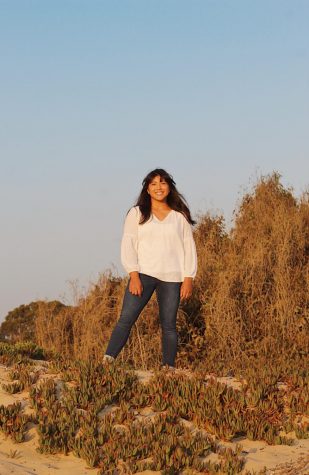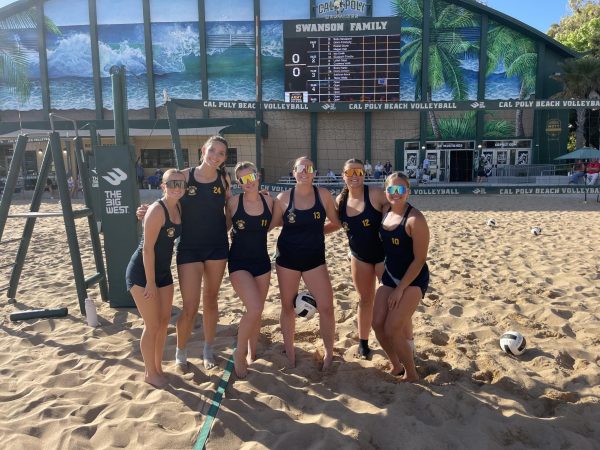AGHS athletes carefully return to Covid-19 constricted conditioning
The lights buzz on, the scoreboard flashes, and the equipment is all set. But there is something missing. There’s no one in the stands, no one cheering. There is only silence. Many Arroyo Grande High School student-athletes are eager to once again hear the roar of cheers from the stands and to play the sport they love.
COVID-19 has put a pause on the regular fall season sporting events. Luckily, the Lucia Mar District has come up with a plan that allows student-athletes to resume their training.
According to the district, so far athletes and their coaches are only allowed to work on “conditioning with [a] focus on individual skill-building.” This is why the school website and announcements have regarded the fall practices as the Return To Athletics (RTA) conditioning period since it is not technically a practice session.
The plan Lucia Mar District laid out permits only 14 students per conditioning session which is why water polo, football, and cross country are scheduled at two different times each day.
Natalie Hurtado, a senior and the Girls’ Assistant Captain for Cross Country stated, “Because there’s not enough space for everyone to practice at the same time we have an a.m. and a p.m. group.”
Hurtado wakes up around 5:15 a.m. to prepare for her conditioning period that begins at 6 a.m. where she meets her coach and the rest of the team by the tennis courts. Due to the early start, prior to the time change, there was very little light which forced the cross country team to mainly run on the track instead of around the town.
Other sports also had to change locations. Volleyball conditioning now takes place on the blacktop instead of the gym and Water Polo conditioning is now hosted at Nipomo High School due to pool renovations.
The district’s RTA plan includes four phases. The Implementation Phase is the preliminary phase where athletes are briefed on the regulations and what would be expected of them. The regulations include: no mixing of separate groups within the sport, everyone must stay six feet apart, equipment cannot be shared, and staff must wear masks throughout the whole conditioning period, while students can take theirs off during exercise.
Anna Kreowski, a senior and a girls varsity water polo athlete said “[Because] our coaches have to keep their masks on at all times… it is kind of hard to hear them sometimes.” This can make it difficult for athletes to fully understand what is being asked of them.
In addition to athletes wearing a mask, withholding of shared equipment, and having to remain six feet apart, they are also required to fill out a health form every day.
Cory Wack, a junior and boys cross country athlete explained, “We have to fill out a form 15 minutes before practice.” From there the coach will check students off to allow them to join the conditioning period that day.
Phase One, which follows the Implementation Phase, consists of actually following these rules, and includes equipment not being shared amongst teammates.
“[W]e are given a ball that cannot be shared,” stated Savannah Porterfield, a senior and an outside hitter for the girls’ varsity volleyball.
This has restricted her sport immensely since volleyball requires a lot of passing and setting.
However, during the last week of October volleyball and water polo were given the green light to share a ball with a partner. This is an example of the transition to Phase 2. This phase permits students to share equipment while maintaining social distance guidelines.
“We are allowed to pass and shoot but that’s it [and] I think it’s going to be really hard to get in game shape,” said Nate Penton, a junior and boys varsity water polo athlete.
As Penton mentioned, it appears trying to stay in “game shape” is a recurring problem in most fall sports. This is why Phase 3 is the last and most anticipated phase: being able to resume regular practice without the COVID-19 restrictions and separation of groups.
Porterfield expressed, “This sport [volleyball] specifically requires teamwork and our team not being able to actually practice the game we want to play [due to COVID restrictions] is extremely hard.”
On the other hand, with an official season being up in the air, some athletes have found a new liking to the slowed process.
“It’s kind of nice to progress slowly into the sport and instead of jumping right in,” said Kreowski.
Even though COVID-19 has changed the way these athletes train, they have gotten creative by finding different ways to keep positive attitudes.
“We’re planning to do intrasquad [cross country] meets so we can compete with each other so they keep us motivated,” stated Wack.
In all, COVID-19 may have taken away normalcy from Arroyo Grande High School’s athletes but it hasn’t taken away their Eagle spirit.
“I’m ready to kick butt… do my business, and continue the sport!” exclaimed Kreowski, and other athletes share the same sentiment.

Madelyn Ferreros is a senior this year and is the Head of the Sports Department of the Eagle Times. This will be her first year being a part of the Eagles...






!["Coaching golf at AGHS is my chance to be a part of [a bigger community], and I am blessed and humbled by the opportunity and the responsibility that comes with it," Schiro said.](https://aghseagletimes.com/wp-content/uploads/2025/05/IMG_5361-600x383.jpg)